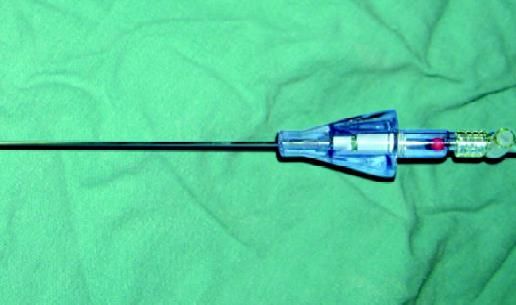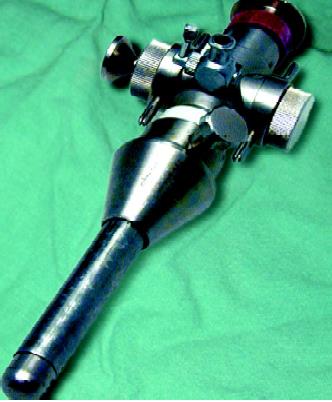Veress Needle and Hasson Cannula in Laparoscopic Surgery
Several factors should be considered at the time of choosing a laparoscopic instrument, including cost, availability, and reliability. Reusable instruments are expensive initially but in the long run, they are cost-effective. The cost of disposable instruments is less compared to reusable but the patient cost is increased. In developing countries, disposable instruments are very rarely used because labor cost is low compare to the cost of a disposable instrument. In Europe and the USA, surgeons often choose to use disposable instruments in order to save high labor costs. The main advantage of disposable instruments is high performance due to its sharpness and reduced chance of disease transmission due to certified high- end factory sterilization. However, once discarded, environmental concerns are raised about disposal and biodegradability of disposable instruments. Ideally, the disposable instrument should not be used repeatedly because handling, sorting, storing, and sterilization make these instruments questionable. The disposable instruments are not sterilized properly by dipping in glutaraldehyde because they are not dismountable. Insulation of disposable instruments also can be torn easily which can lead to electrosurgical injuries.
Veress Needle
Veress needle was invented by a chest physician for aspiration of pleural effusion keeping in mind that its spring mechanism and the blunt tip will prevent the injury of lung tissue. Veress needle consists of an outer cannula with a beveled needlepoint for cutting through tissues. Inside the cannula is an inner stylet, which is loaded with a spring that “springs forward” in response to the sudden decrease in pressure encountered upon crossing the abdominal wall and entering the peritoneal cavity. The lateral hole on this stylet enables CO2 gas to be delivered intra-abdominally.
Veress needle is used for creating initial pneumoperitoneum so that the trocar can enter safely and the distance of the abdominal wall from the abdominal viscera should increase. Veress needle technique is the most widely practiced way of access. Before using the Veress needle every time it should be checked for its potency and spring action. Veress needle is available in three lengths 80 mm, 100 mm, 120 mm. In obese patients, 120 mm and in very thin patients with scaphoid abdomen 80 mm Veress needle should be used. Veress needle should be held like a dart at the time of insertion.

Veress needle
Hasson Cannula
In an effort to decrease the incidence of injuries associated with the blind access of the peritoneal cavity with the Veress needle and the initial trocar, Hassan proposed a blunt (open) mini-laparotomy access. He develops a reusable device of similar design to a standard cannula but attached an olive-shaped cone (sleeve).
Several disposable open-access devices have been released. They are similar to the reusable system originally described by Hasson except that the stay sutures are attached directly to the olive, allowing manipulation of the cannula depth without detaching the stay sutures. The basic method of peritoneal access, however, has remained the same.

Hasson’s trocar and cannula
This cone would slide up and down the shaft of the cannula and would form an airtight seal at the fascial opening. In addition, the sharp trocar was replaced by a blunt obturator. This cannula is held in place by the use of stay sutures passed through the fascial edges and attached to the body of the cannula.
The reason the olive sleeve is designed to slide up and down the shaft of the cannula is to allow for variations in abdominal wall thickness. The tension provided by the fascial sutures when attached to the device serves to create a seal to prevent gas leakage. To adjust the length of the cannula within the abdominal wall, the fascial sutures require detachment from the device, adjustment of the olive sleeve, and reattachment of the sutures.
Several factors should be considered at the time of choosing a laparoscopic instrument, including cost, availability, and reliability. Reusable instruments are expensive initially but in the long run, they are cost-effective. The cost of disposable instruments is less compared to reusable but the patient cost is increased. In developing countries, disposable instruments are very rarely used because labor cost is low compare to the cost of a disposable instrument. In Europe and the USA, surgeons often choose to use disposable instruments in order to save high labor costs. The main advantage of disposable instruments is high performance due to its sharpness and reduced chance of disease transmission due to certified high- end factory sterilization. However, once discarded, environmental concerns are raised about disposal and biodegradability of disposable instruments. Ideally, the disposable instrument should not be used repeatedly because handling, sorting, storing, and sterilization make these instruments questionable. The disposable instruments are not sterilized properly by dipping in glutaraldehyde because they are not dismountable. Insulation of disposable instruments also can be torn easily which can lead to electrosurgical injuries.
Veress Needle
Veress needle was invented by a chest physician for aspiration of pleural effusion keeping in mind that its spring mechanism and the blunt tip will prevent the injury of lung tissue. Veress needle consists of an outer cannula with a beveled needlepoint for cutting through tissues. Inside the cannula is an inner stylet, which is loaded with a spring that “springs forward” in response to the sudden decrease in pressure encountered upon crossing the abdominal wall and entering the peritoneal cavity. The lateral hole on this stylet enables CO2 gas to be delivered intra-abdominally.
Veress needle is used for creating initial pneumoperitoneum so that the trocar can enter safely and the distance of the abdominal wall from the abdominal viscera should increase. Veress needle technique is the most widely practiced way of access. Before using the Veress needle every time it should be checked for its potency and spring action. Veress needle is available in three lengths 80 mm, 100 mm, 120 mm. In obese patients, 120 mm and in very thin patients with scaphoid abdomen 80 mm Veress needle should be used. Veress needle should be held like a dart at the time of insertion.

Veress needle
Hasson Cannula
In an effort to decrease the incidence of injuries associated with the blind access of the peritoneal cavity with the Veress needle and the initial trocar, Hassan proposed a blunt (open) mini-laparotomy access. He develops a reusable device of similar design to a standard cannula but attached an olive-shaped cone (sleeve).
Several disposable open-access devices have been released. They are similar to the reusable system originally described by Hasson except that the stay sutures are attached directly to the olive, allowing manipulation of the cannula depth without detaching the stay sutures. The basic method of peritoneal access, however, has remained the same.

Hasson’s trocar and cannula
This cone would slide up and down the shaft of the cannula and would form an airtight seal at the fascial opening. In addition, the sharp trocar was replaced by a blunt obturator. This cannula is held in place by the use of stay sutures passed through the fascial edges and attached to the body of the cannula.
The reason the olive sleeve is designed to slide up and down the shaft of the cannula is to allow for variations in abdominal wall thickness. The tension provided by the fascial sutures when attached to the device serves to create a seal to prevent gas leakage. To adjust the length of the cannula within the abdominal wall, the fascial sutures require detachment from the device, adjustment of the olive sleeve, and reattachment of the sutures.





